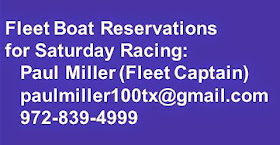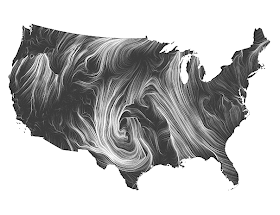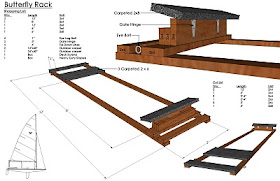WHEN TO TACK
at 8.09.2011
Doug Peckover (c) 2011
Pam is always asking me questions about sailing, like “why did you go right?” Sometimes it’s easy to answer and sometimes it’s really hard because, for me, it’s a gut feeling that is hard to explain. Getting me to answer her questions has really helped my sailing because it forces me to understand what I do instinctively and verbalize it. So here is my most adventurous article yet – explaining my gut feelings.
To review, the most important factor about sailing upwind is deciding when to tack. Do you bang the corner that worked last time? Do you watch for and try to protect the inside of the next shift? Do you connect the dots that you see on the water? Do you cover the boat that you want to beat? Do you stay flexible and wait for a Zen moment? Here’s the basic diagram we’ll use:
The orange represents sailing the course, white is sailing the competition, and blue represents sailing the wind patterns that you see on the water. When you round the bottom mark, you want to start on the tack that takes you closest to the weather mark (orange), but you want to also keep an eye on your competition (white). And if there’s obviously more wind on one side, then you want to head for it (blue). These factors all have to be considered as shown at the bottom of the diagram where the orange (40%), white (30%), and blue (30%) and the result of weighing these factors is deciding what to do. Some examples:
- If there is no obvious side favored, go with the crowd.
- If the left has more wind and starboard tack is closer to the mark, but the competition is going right, go middle left but keep your eye on the right.
- If the course is square and the fleet splits evenly but there is more wind on the right, go right but keep your eye on the left.
The choice is usually between not tacking, tacking to head towards the other side of the course, or tacking twice to stay with someone who is giving you dirty air.
Things change as you approach the top mark because the course and water are less of a factor. This is because there is less course and water to work with and the competitors start to converge to round the mark. It’s almost all tactical against your competition (increased to 95%). Should you protect the right? Is getting greedy at the mark likely to pay off? How crowded is the lay line likely to be? Should you get inside the last shift which is always persistent? The transition from the bottom mark to the top mark can be gradual, as the course and water gradually become less important and your competition becomes more important.
So, we now have a basic idea of how to measure gut feelings, or for the engineers amongst us, quantifying our options. But it gets much more interesting in different events and even in different legs of the same race. When I won my first Laser worlds in Chile, I was up against Mark Bethwaite (now with 8 world championships) and Keith Wilkins (this week on his way to winning his 12th world championship). My strategy to beat these sailing superstars was custom-tailored for these Worlds because I knew that both of these sailors had forgotten more about sailing the course and reading the wind than I will ever know. So, this was my strategy:
I focused almost all of my attention on where these two sailors went and then covered them without interfering so they could teach me. Beating these two world-class sailors was dependent entirely on watching for the little mistakes that everyone makes. For this reason, at world championships I prefer to rely on others to decide when to tack and which side of the course to play. Winning my second Laser worlds in Korea was different because Mark and Keith were not there, the current favored staying close to shore on the left side of the course, and I was on my way to being legally blind and could not see the course or water patterns. So, my strategy was more about protecting the left side and staying with the competition:
Another important factor was that world championships are held in open water where the wind is very steady, so the blue conditions observations are barely a factor.
The strategy for lake sailing is completely different because of the constant changes in wind direction and pressure. Here’s an extreme example of how former Butterfly champion Paul Foerster won a match-racing heat at the Pam Am Games which were held at RCYC on Lake Ray Hubbard:
Paul started right on top of his competitor and was pulling away when the gun went off. In match racing, you only have to beat the one boat and there was no way this other boat could catch and pass such a skilled sailor. So, what did Paul do? He immediately tacked away, went hard right, and won the race by more than two minutes. Paul read something on the water or in the clouds that assured him that the course and competition were not factors. Very few people in the world have enough skill or confidence to do this.
And you have to be flexible. Most fleets go left on the first beat, so the course is not as important as boat speed and staying with the competition. But you still want to protect the right if there is more wind there:
On the second windward leg however, the fleet tends to go right, so the course and water factors are more balanced. But this is not always the case. In the second race last Saturday, I led going into the second beat and the two boats behind me followed going right. No surprises here. Covering is how you protect a lead:
But the wind shifted more to the right and I wanted to tack, partly because others had tacked and were in a better breeze, and partly because sailing on a big knock was feeling less and less worthwhile. But tacking would mean not covering and giving my two closest competitors the separation they would need to catch their own shift or pressure. So I waited a very long 30 seconds and then decided to tack. Here’s what this leg felt like:
The longer I waited, the less important the closest competition was as the water and course factors increased in importance and eventually outweighed the feelings of needing to cover. Thankfully, it worked – the two others soon tacked to follow me. Had they continued they could have found their own right shift and could have beaten me.
There are many other situations that can be shown with many other diagrams, and these might be a useful tool for chalk talks after racing. The key is feeling how much importance to put on each of the course, the competition, and what you see on the water. And knowing that in sailboat racing, these factors change all the time and you have to look around, assess what is happening, and be prepared to tack at any time.













8/11/2011 9:45 AM
Another great article!
8/14/2011 11:01 AM
Always think about where you are on the race course, evaluating the best possible decision ...Go Doug!!